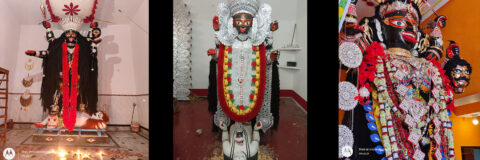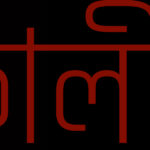Maa Mahishkhagi of Shantipur – The Fierce Mother of Faith and Fire
In the long and storied history of Shantipur’s Kali Puja, one name gleams with a fierce, ancient radiance — Maa Mahishkhagi.
Centuries ago, this town on the banks of the Ganga echoed with the sound of conch shells, drums, and ritual chants as devotees gathered to worship the Goddess in her most primal form. In those early times, buffalo sacrifices were an integral part of the worship — a symbolic offering of human ego and ignorance to the all-consuming Mother. From that ancient custom came her name: Mahishkhagi, meaning “She who accepts the buffalo offering.”
Over time, though the practice of animal sacrifice faded, the spirit of devotion endured — fierce, personal, and unswerving. What makes this Puja truly unique is that its core rituals have survived intact, passed down through generations of priestly families and local devotees.
Even today, after the sacred rites are complete, the immersion of Maa Mahishkhagi — the Niranjan ceremony — takes place in a way found almost nowhere else in Bengal. The Goddess’s idol is not wheeled on a cart or carried in a vehicle; she is borne on the shoulders of her devotees, moving through the narrow lanes of Shantipur to the river’s edge, accompanied by drums, chants, and fire-torches. It is said that as the idol sways on the devotees’ shoulders, the Mother herself dances — her energy coursing through those who carry her.
This is not just ritual; it is living theatre — a moment where faith, history, and physical devotion merge into one. The entire town becomes a river of sound and movement, flowing with a single emotion: bhakti, pure love and surrender.
So when the dark night of Kali Puja arrives, Shantipur glows — not only with lamps and incense, but with centuries of living heritage. The stories of the Shakta saints, the echoes of ancient mantras, and the courage of faith all converge in the worship of Maa Mahishkhagi.
Come, walk the same streets that have carried this devotion for hundreds of years.
Come, feel the pulse of Bengal’s oldest Kali traditions in every drumbeat and flame.
Come to Shantipur this Kali Puja, and let the blessings of Maa Mahishkhagi touch your heart — the Mother who accepts all offerings, fierce yet compassionate, ancient yet eternally alive.
Bama Kali of Shantipur — The Goddess Who Dances on Her Devotees’ Shoulders
In the old town of Shantipur, where every lane hums with memory and devotion, lives a legend that has burned bright for nearly five hundred years — the worship of Maa Bama Kali.
Long before electricity lit the streets, Shantipur’s nights of Kali Puja were illuminated by a thousand flaming torches. As dusk fell, devotees would carry their Mother — the fierce, dark goddess — through the narrow lanes, her idol swaying on their shoulders in the shimmering light of fire. Even today, that torchlit procession remains unchanged — a living ember from another century.
The goddess herself bears a rare, potent form. Unlike the gentler Dakshina Kali, who places her right foot upon Shiva, Bama Kali’s left foot rests on his chest. This inversion — the “left-handed” stance — is not a mistake but a mystery. It embodies the Tantric truth that creation and destruction, chaos and compassion, exist in perfect balance. Her name comes from that stance: Bama, meaning “left,” symbolizing the untamed, transformative power of the divine feminine.
When the Puja ends and the final offerings have been made, Shantipur awakens to its most breathtaking ritual — the immersion dance. As drums thunder and chants rise, the devotees lift the enormous idol of the Mother onto a bamboo platform and bear her on their shoulders toward the river. Behind them stretches a human tide — men, women, children, their faces lit by firelight and faith.
At that moment, something uncanny happens. The crowd begins to move in rhythm — swaying, leaping, trembling under the weight of devotion. The idol seems to dance with them. To those who watch from afar, it feels as though the goddess herself has come alive, dancing through her devotees, possessed by her own divinity.
For generations, this has been the soul of Shantipur’s Kali Puja. Unlike other places where festivities stretch across several days, here the goddess is immersed the very next morning. The briefness intensifies the devotion — a night of fire, a dawn of farewell. And each year, the same miracle repeats: the flames, the drums, the dancing shoulders, the living goddess.
Today, videos of Shantipur’s Bama Kali Bhasan — the “immersion dance” — have taken the internet by storm. But what the camera captures as spectacle is, for the people of Shantipur, an act of faith. It is not a performance; it is a pilgrimage in motion, a centuries-old conversation between the human and the divine.
The ritual’s hypnotic beauty lies in its simplicity — torches lighting the night, bodies moving as one, devotion transformed into movement. As the flames flicker on her dark face, the Mother seems both fierce and tender — a mirror of life itself.
So when the new moon of Kali Puja arrives, and the night hums with conch shells and drums, thousands gather again on Shantipur’s streets. Some come to pray, others to witness. But all leave with the same feeling — that somewhere, amid the smoke and firelight, Bama Kali Ma truly dances.
The Living Legend of Chanduni Bari
In the heart of Shantipur, where the air still hums with the songs of devotion and time seems to fold upon itself, stands an ancient house — Chanduni Bari. Its courtyards have witnessed over five centuries of worship, faith, and firelight. And at its centre burns the legend of Maa Bama Kali, the goddess who dances on the shoulders of her devotees.
No inscription marks the exact beginning. There are no temple scrolls, no royal decrees. What survives is something older — memory, carried in story and ritual.
It begins, they say, with a young man named Gopinath, a devout soul from the ancestral Chanduni family. One quiet morning, as he worshipped his sacred Narayan-shila — a smooth stone symbolizing Lord Vishnu — a little girl appeared before him. She asked, with childlike insistence, for a bit of prasad. Irritated, Gopinath refused and turned her away. When he looked again, she had vanished.
That night, the same girl returned — not in waking life but in a dream radiant with divine light.
“Build me an altar,” she said, “with five skulls beneath it — a panchamundir ashan — and worship me as Chanduni Ma on the dark night of Kartik Amavasya. Thus shall I be revealed.”
When Gopinath awoke, he understood. With his mother’s help, he fashioned the first idol of the goddess, set it beneath a banyan tree near their home, and began the worship that would outlive them all.
History, or perhaps destiny, adds another thread: Gopinath’s younger brother, Kashinath, is said to have been tutor to Sri Chaitanya Mahaprabhu, the great saint of the Bhakti movement. That single connection anchors the Chanduni Bari Kali Puja in the 16th century, giving it an age of nearly five hundred years.
From that humble altar under the tree grew a tradition — first a household shrine, then a community temple, and finally a festival that fills the whole town with its pulse. The house became known as Chanduni Bari (Bari meaning “great ancestral home”), and the surrounding area took its name: Chanduni Para.
But the spirit of the worship has never changed. It remains, as it began — intimate, fiery, and profoundly human. A family’s private act of faith that became Shantipur’s beating heart.


